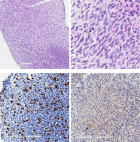Abstract
Case Report
A Case Report on Paradoxical Emboli
You Li* and Jason Wheeler
Published: 17 October, 2024 | Volume 8 - Issue 1 | Pages: 004-007
Venous Thromboembolism (VTE) is a major public health concern, affecting approximately 900,000 people annually in the United States. In rare cases, a Patent Foramen Ovale (PFO) may allow a venous thrombus to cross into the arterial circulation, causing a paradoxical embolism. This case report presents a 46-year-old male who developed left renal artery stenosis after a paradoxical embolism, likely triggered by a prolonged flight and binge alcohol consumption. The patient was found to have a moderate-sized PFO and renal infarction, confirmed by imaging studies. Despite initial anticoagulation therapy and a planned stenting procedure, intraoperative findings revealed only mild stenosis, leading to cancellation of the stent placement. The patient ultimately underwent PFO closure with an Amplatzer Talisman device. This case underscores the diagnostic challenges in managing paradoxical embolism and the need for individualized treatment, particularly concerning anticoagulation duration, the decision for PFO closure, and post-procedural antithrombotic therapy. Further research is required to establish optimal management strategies for cryptogenic embolic events.
Read Full Article HTML DOI: 10.29328/journal.avm.1001019 Cite this Article Read Full Article PDF
Keywords:
Venous thromboembolism; Paradoxical embolism; Patent foramen ovale; Renal artery stenosis; Cryptogenic stroke; Anticoagulation therapy; PFO closure
References
- Centers for Disease Control and Prevention. Venous thromboembolism (blood clots): data and statistics. Updated February 27, 2023. Available from: https://www.cdc.gov/blood-clots/data-research/facts-stats/index.html
- Hartman RP, Kawashima A. American Academy of Family Physicians. Acute venous thromboembolism: a review of the evidence. Am Fam Physician. 2009;80(3):273-279. Available from: https://www.aafp.org/pubs/afp/issues/2009/0801/p273.html
- Wang Y, Cheng H, Liu Y, Liu F, Zhang L, Li X, et al. Current understanding of cryptogenic stroke and its pathophysiology. J Neurol Sci. 2014;342(1-2):8-18. Available from: https://www.ncbi.nlm.nih.gov/pmc/articles/PMC4081166/
- Odutayo A, Hsiao AJ, Wiering L, et al. Venous thromboembolism in patients with heart failure: a systematic review and meta-analysis. J Am Heart Assoc. 2018;7(3). Available from: https://www.ahajournals.org/doi/full/10.1161/JAHA.117.007146
- Heit JA, Spencer FA, White RH. The epidemiology of venous thromboembolism. J Thromb Haemost. 2016;14(4):1104-5. https://www.nejm.org/doi/full/10.1056/NEJMoa1610057
- Sutherland GR, Tzeng YS, Wang YL, et al. Venous thromboembolism in cancer: a focus on diagnosis and treatment. N Engl J Med. 2017;376(15):1478-87. Available from: https://www.nejm.org/doi/full/10.1056/NEJMoa1705915
- Kahn SR, Lim W, Dunn AS, et al. Prevention of VTE in non-surgical patients: a systematic review. N Engl J Med. 2017;377(9):843-52. Available from: https://www.nejm.org/doi/full/10.1056/NEJMoa1707404
- O’Donnell JS, Eikelboom JW, MacCallum PA. Venous thromboembolism: prevention, diagnosis and treatment. BMJ. 2018;362. Available from: https://www.bmj.com/content/362/bmj.k2515
- Chalmers J, Eikendal T, Voehringer D, et al. Thrombosis in pregnancy: pathophysiology and clinical implications. In: Greer I, et al., editors. Obstetric hematology. Oxford University Press; 2020. Available from: https://academic.oup.com/book/54238/chapter-abstract/422449704?redirectedFrom=fulltext
- Lentz SR. Blood coagulation. J Clin Invest. 2021 Jun 1;131(11).
Figures:
Similar Articles
-
Atypical manifestations of pulmonary embolismOscar MP Jolobe*. Atypical manifestations of pulmonary embolism. . 2020 doi: 10.29328/journal.avm.1001012; 4: 008-018
-
Clinical characteristics in STEMI-like aortic dissection versus STEMI-like pulmonary embolismOscar MP Jolobe*. Clinical characteristics in STEMI-like aortic dissection versus STEMI-like pulmonary embolism. . 2020 doi: 10.29328/journal.avm.1001013; 4: 019-030
-
A Case Report on Paradoxical EmboliYou Li* and Jason Wheeler. A Case Report on Paradoxical Emboli. . 2024 doi: 10.29328/journal.avm.1001019; 8: 004-007
Recently Viewed
-
Experience with trans radial uterine artery embolisation for uterine fibroids in a tertiary center in Saudi ArabiaGehan Farid*,Reem Kamal,Mohammed Thani Al-Shammari,Mohamed Swaraldahab,Hassan Swaraldahab. Experience with trans radial uterine artery embolisation for uterine fibroids in a tertiary center in Saudi Arabia. Clin J Obstet Gynecol. 2020: doi: 10.29328/journal.cjog.1001072; 3: 167-174
-
Drug Rehabilitation Centre-based Survey on Drug Dependence in District Shimla Himachal PradeshKanishka Saini,Palak Sharma,Bhawna Sharma*,Atul Kumar Dubey,Muskan Bhatnoo,Prajkta Thakur,Vanshika Chandel,Ritika Sinha. Drug Rehabilitation Centre-based Survey on Drug Dependence in District Shimla Himachal Pradesh. J Addict Ther Res. 2025: doi: 10.29328/journal.jatr.1001032; 9: 001-006
-
Overview on current approach on recurrent miscarriage and threatened miscarriageBasant Sharma*,Jagat Deep,Chandrika Pandit,Bina Basnyat,Bandana Khanal,BB Raut,Brij Mohan Rajak,Deepak Patel,Rangina Laikangbam,Rajendra Basyal. Overview on current approach on recurrent miscarriage and threatened miscarriage. Clin J Obstet Gynecol. 2020: doi: 10.29328/journal.cjog.1001070; 3: 151-157
-
4-year recurrence risk factors after tension-free vaginal tape-obturator as a treatment of stress urinary incontinenceDe Miguel Manso S*,García García E,Gobernado Tejedor JA,Badillo Bercebal CE,Viruega Cuaresma D,González Martín JI. 4-year recurrence risk factors after tension-free vaginal tape-obturator as a treatment of stress urinary incontinence. Clin J Obstet Gynecol. 2020: doi: 10.29328/journal.cjog.1001069; 3: 145-150
-
A Comparative Study of Metoprolol and Amlodipine on Mortality, Disability and Complication in Acute StrokeJayantee Kalita*,Dhiraj Kumar,Nagendra B Gutti,Sandeep K Gupta,Anadi Mishra,Vivek Singh. A Comparative Study of Metoprolol and Amlodipine on Mortality, Disability and Complication in Acute Stroke. J Neurosci Neurol Disord. 2025: doi: 10.29328/journal.jnnd.1001108; 9: 039-045
Most Viewed
-
Evaluation of Biostimulants Based on Recovered Protein Hydrolysates from Animal By-products as Plant Growth EnhancersH Pérez-Aguilar*, M Lacruz-Asaro, F Arán-Ais. Evaluation of Biostimulants Based on Recovered Protein Hydrolysates from Animal By-products as Plant Growth Enhancers. J Plant Sci Phytopathol. 2023 doi: 10.29328/journal.jpsp.1001104; 7: 042-047
-
Sinonasal Myxoma Extending into the Orbit in a 4-Year Old: A Case PresentationJulian A Purrinos*, Ramzi Younis. Sinonasal Myxoma Extending into the Orbit in a 4-Year Old: A Case Presentation. Arch Case Rep. 2024 doi: 10.29328/journal.acr.1001099; 8: 075-077
-
Feasibility study of magnetic sensing for detecting single-neuron action potentialsDenis Tonini,Kai Wu,Renata Saha,Jian-Ping Wang*. Feasibility study of magnetic sensing for detecting single-neuron action potentials. Ann Biomed Sci Eng. 2022 doi: 10.29328/journal.abse.1001018; 6: 019-029
-
Pediatric Dysgerminoma: Unveiling a Rare Ovarian TumorFaten Limaiem*, Khalil Saffar, Ahmed Halouani. Pediatric Dysgerminoma: Unveiling a Rare Ovarian Tumor. Arch Case Rep. 2024 doi: 10.29328/journal.acr.1001087; 8: 010-013
-
Physical activity can change the physiological and psychological circumstances during COVID-19 pandemic: A narrative reviewKhashayar Maroufi*. Physical activity can change the physiological and psychological circumstances during COVID-19 pandemic: A narrative review. J Sports Med Ther. 2021 doi: 10.29328/journal.jsmt.1001051; 6: 001-007

HSPI: We're glad you're here. Please click "create a new Query" if you are a new visitor to our website and need further information from us.
If you are already a member of our network and need to keep track of any developments regarding a question you have already submitted, click "take me to my Query."
















































































































































